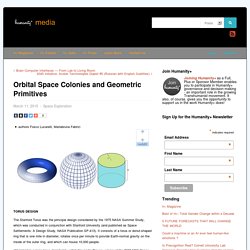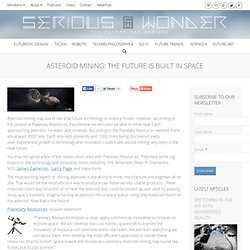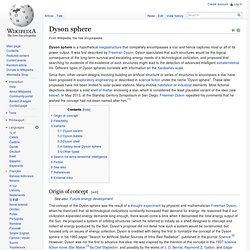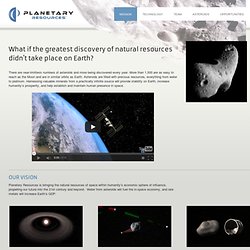

Orbital Space Colonies and Geometric Primitives - h+ Media. The Stanford Torus was the principal design considered by the 1975 NASA Summer Study, which was conducted in conjunction with Stanford University (and published as Space Settlements: A Design Study, NASA Publication SP-413).

It consists of a torus or donut-shaped ring that is one mile in diameter, rotates once per minute to provide Earth-normal gravity on the inside of the outer ring, and which can house 10,000 people. “Abalakin” is a large torus depicted by artist Alexander Preuss, winner of the 2008 NSS Space Settlement Calendar Art Contest. © Alexander Preuss. “Vademecum” is a 2006 student design similar in size to the Stanford Torus but with a more efficient shape. Painting copyright by Dan Roam courtesy of the artist. Stanford Torus external view. Stanford Torus cutaway view. Stanford Torus interior. The Engine Burns Blue. Asteroid Mining: The Future Is Built In Space. Asteroid mining may sound like a far future technology or science fiction.

However, according to the people at Planetary Resources, they believe we will soon be able to mine near Earth approaching asteroids for water and minerals. According to the Planetary Resources website there are at least 9000 near Earth asteroids presently and 1000 more being discovered every year. Exponential growth in technology and innovation could make astroid mining very likely in the near future. You may recognize a few of the names associated with Planetary Resources. They have some big players in the technology and innovation fields including: Eric Anderson, Peter H. The most exciting aspect of mining asteroids is the ability to mine, manufacture and engineer all on site.
Planetary Resources mission statement: “Planetary Resources mission is clear: apply commercial, innovative techniques to explore space. [youtube responsive=true id="7fYYPN0BdBw" align="left"] Future Implications: Like this article? Solarsystembodies.jpg (JPEG Image, 11060 × 1000 pixels) Dyson sphere. Dyson sphere is a hypothetical megastructure that completely encompasses a star and hence captures most or all of its power output.

It was first described by Freeman Dyson. Dyson speculated that such structures would be the logical consequence of the long-term survival and escalating energy needs of a technological civilization, and proposed that searching for evidence of the existence of such structures might lead to the detection of advanced intelligent extraterrestrial life. Different types of Dyson spheres correlate with information on the Kardashev scale.
Since then, other variant designs involving building an artificial structure or series of structures to encompass a star have been proposed in exploratory engineering or described in science fiction under the name "Dyson sphere". These later proposals have not been limited to solar-power stations. Origin of concept[edit] Feasibility[edit] 11 of the Weirdest Solutions to the Fermi Paradox. Most people take it for granted that we have yet to make contact with an extraterrestrial civilization.

Trouble is, the numbers don’t add up. Our Galaxy is so old that every corner of it should have been visited many, many times over by now. No theory to date has satisfactorily explained away this Great Silence, so it’s time to think outside the box. Here are eleven of the weirdest solutions to the Fermi Paradox.
There's no shortage of solutions to the Fermi Paradox. But for the purposes of this discussion, we’re going to look at some of the more bizarre and arcane solutions to the Fermi Paradox. 1. Though it sounds like something from a Twilight Zone episode, it’s quite possible that we’re stuck inside some kind of celestial cage. 2. Home. The Asteroid Mining Company – Mission. There are near-limitless numbers of asteroids and more being discovered every year.

More than 1,500 are as easy to reach as the Moon and are in similar orbits as Earth. Asteroids are filled with precious resources, everything from water to platinum. Harnessing valuable minerals from a practically infinite source will provide stability on Earth, increase humanity’s prosperity, and help establish and maintain human presence in space. Our Vision Planetary Resources is bringing the natural resources of space within humanity’s economic sphere of influence, propelling our future into the 21st century and beyond.
Asteroids are the low-hanging fruit of the Solar System. Low cost commercial robotic spacecraft will explore asteroids and determine their position, composition, and accessibility of resources. Deep Space Industries – MISSION. O'Neill cylinder. Artist's depiction of a pair of O'Neill cylinders The O'Neill cylinder (also called an O'Neill colony) is a space settlement design proposed by American physicist Gerard K.

O'Neill in his 1976 book The High Frontier: Human Colonies in Space.[1] O'Neill proposed the colonization of space for the 21st century, using materials extracted from the Moon and later from asteroids.[2] Interior view, showing alternating land and window stripes Background[edit] While teaching undergraduate physics at Princeton University, O'Neill set his students the task of designing large structures in outer space, with the intent of showing that living in space could be desirable.
O'Neill's project was not completely without precedent. Islands One, Two and Three[edit] O'Neill created three reference designs, nicknamed "islands": Island One[edit] Island Two[edit] Island Two is also spherical in design, and is also 1,600 meters in diameter.